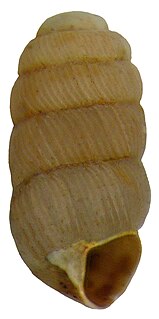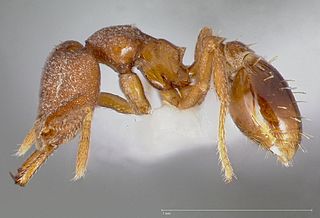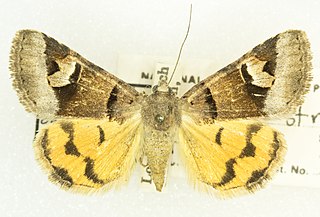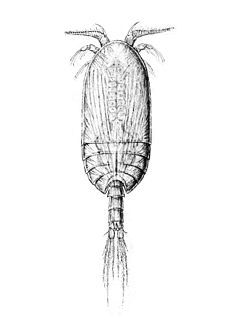Zenkerella perplexa is a species of plant in the family Fabaceae. It is found only in Tanzania, where it is endemic to the Eastern Arc forests.
The chestnut clearwing moth was a species of moth in the family Tischeriidae. It was endemic to the United States. It is characterized by clear wings and a dark and metallic blue abdomen seemingly wrapped in a yellow band of color. It became extinct due to chestnut blight obliterating its primary food source, the American chestnut.

Truncatellina is a genus of very small air-breathing land snails, terrestrial pulmonate gastropod mollusks in the family Truncatellinidae.

Strumigenys is a genus of ants in the subfamily Myrmicinae.

Helicia is a genus of 110 species of trees and shrubs, constituting part of the plant family Proteaceae. They grow naturally in rainforests throughout tropical South and Southeast Asia, including India, Sri Lanka, Indochina, Peninsular Malaysia to New Guinea and as far south as New South Wales.

Hiraea is a genus in the Malpighiaceae, a family of about 75 genera of flowering plants in the order Malpighiales. Hiraea comprises over 55 species of woody vines and shrubs found in diverse habitats, except very dry vegetation types, in the New World tropics and subtropics from western Mexico to Paraguay and adjacent Argentina and southeastern Brazil; it also occurs in the Lesser Antilles in Grenada and St. Lucia.

Hadena perplexa, the tawny shears or pod lover, is a species of moth of the family Noctuidae. It is found in Morocco, Algeria, Tunisia, Europe, Turkey, Israel, Lebanon, Syria, Jordan, Iran, Iraq, northern Asia, Central Asia, northern India and western China.

Drasteria perplexa, the perplexing or perplexed arches, is a moth of the family Erebidae. The species was first described by Henry Edwards in 1884. It is found in North America from Alberta and Saskatchewan south to Colorado and Arizona.

Austruca perplexa is a species of fiddler crab. It is found from the Ryukyu Islands, Japan to India, throughout the Malay Archipelago, along eastern Australian coasts from Queensland to New South Wales, and in various Pacific islands, including Fiji, Tonga and Vanuatu.

Mesoclemmys is a South American genus of turtle in the Chelidae family.

Conasprella perplexa is a species of sea snail, a marine gastropod mollusk in the family Conidae, the cone snails and their allies.

The World's 25 Most Endangered Primates is a list of highly endangered primate species selected and published by the International Union for Conservation of Nature (IUCN) Species Survival Commission (SSC) Primate Specialist Group (PSG), the International Primatological Society (IPS), Global Wildlife Conservation (GWC), and Bristol Zoological Society (BZS). The IUCN/SSC PSG worked with Conservation International (CI) to start the list in 2000, but in 2002, during the 19th Congress of the International Primatological Society, primatologists reviewed and debated the list, resulting in the 2002–2004 revision and the endorsement of the IPS. The publication was a joint project between the three conservation organizations until the 2012–2014 list when BZS was added as a publisher. The 2018–2020 list was the first time Conservation International was not among the publishers, replaced instead by GWC. The list has been revised every two years following the biannual Congress of the IPS. Starting with the 2004–2006 report, the title changed to "Primates in Peril: The World's 25 Most Endangered Primates". That same year, the list began to provide information about each species, including their conservation status and the threats they face in the wild. The species text is written in collaboration with experts from the field, with 60 people contributing to the 2006–2008 report and 85 people contributing to the 2008–2010 report. The 2004–2006 and 2006–2008 reports were published in the IUCN/SSC PSG journal Primate Conservation,, since then they have been published as independent publications.

Encarsia perplexa is a tiny parasitic wasp, a parasitoid of the citrus blackfly, Aleurocanthus woglumi, which is a global pest of citrus trees. It was originally misidentified as Encarsia opulenta, but was recorded as a new species in 1998. It is a native of Asia but has been introduced to many other parts of the world as a means of controlling the citrus blackfly.

Platycopiidae is a family of copepods. Until the description of Nanocopia in 1988, it contained the single genus Platycopia. It now contains four genera, three of which are monotypic; the exception is Platycopia, with 8 species.
Mesoclemmys perplexa is a species of turtle from Northeast Brazil.
Kuschelina perplexa is a species of flea beetle in the family Chrysomelidae. It is found in North America.

Raphitoma perplexa is an extinct species of sea snail, a marine gastropod mollusc in the family Raphitomidae.












